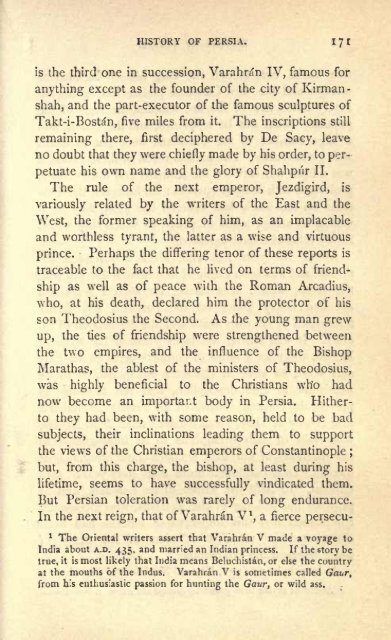Persia from the Earliest Period to the Arab
Persia from the Earliest Period to the Arab
Persia from the Earliest Period to the Arab
Create successful ePaper yourself
Turn your PDF publications into a flip-book with our unique Google optimized e-Paper software.
HISTORY OF PERSIA. iyi<br />
is <strong>the</strong> third one in succession, Varahn'n IV, famous for<br />
anything except as <strong>the</strong> founder of <strong>the</strong> city of Kirmanshah,<br />
and <strong>the</strong> part-execu<strong>to</strong>r of <strong>the</strong> famous sculptures of<br />
Takt-i-Bostdn, five miles <strong>from</strong> it. The inscriptions still<br />
remaining <strong>the</strong>re, first deciphered by De Sacy, leave<br />
no doubt that <strong>the</strong>y were chiefly made by his order, <strong>to</strong> per-<br />
petuate his own name and <strong>the</strong> glory of Shahpur II.<br />
The rule of <strong>the</strong> next emperor, Jezdigird, is<br />
variously related by<br />
<strong>the</strong> writers of <strong>the</strong> East and <strong>the</strong><br />
West, <strong>the</strong> former speaking of him, as an implacable<br />
and worthless tyrant, <strong>the</strong> latter as a wise and virtuous<br />
prince. Perhaps <strong>the</strong> differing tenor of <strong>the</strong>se reports is<br />
traceable <strong>to</strong> <strong>the</strong> fact that he lived on terms of friend-<br />
ship as well as of peace with <strong>the</strong> Roman Arcadius,<br />
who, at his death, declared him <strong>the</strong> protec<strong>to</strong>r of his<br />
son Theodosius <strong>the</strong> Second. As <strong>the</strong> young man grew<br />
up, <strong>the</strong> ties of friendship were streng<strong>the</strong>ned between<br />
<strong>the</strong> two empires, and <strong>the</strong> influence of <strong>the</strong> Bishop<br />
Marathas, <strong>the</strong> ablest of <strong>the</strong> ministers of Theodosius,<br />
was highly beneficial <strong>to</strong> <strong>the</strong> Christians who had<br />
now become an important body in <strong>Persia</strong>. Hi<strong>the</strong>r-<br />
<strong>to</strong> <strong>the</strong>y had been, with some reason, held <strong>to</strong> be bad<br />
subjects, <strong>the</strong>ir inclinations leading <strong>the</strong>m <strong>to</strong> support<br />
<strong>the</strong> views of <strong>the</strong> Christian emperors of Constantinople ;<br />
but, <strong>from</strong> this charge, <strong>the</strong> bishop, at least during his<br />
lifetime, seems <strong>to</strong> have successfully vindicated <strong>the</strong>m.<br />
But <strong>Persia</strong>n <strong>to</strong>leration was rarely of long endurance.<br />
In <strong>the</strong> next reign, that of Varahran V 1<br />
, a fierce persecu-<br />
1 The Oriental writers assert that Varahran V made a voyage <strong>to</strong><br />
India about A.D. 435, and married an Indian princess. If <strong>the</strong> s<strong>to</strong>ry be<br />
true, it is most likely that India means Beluchistan, or else <strong>the</strong> country<br />
at <strong>the</strong> mouths of <strong>the</strong> Indus. Varahran V is sometimes called Gatir,<br />
<strong>from</strong> his enthusiastic passion for hunting <strong>the</strong> Gaur, or wild ass.

















